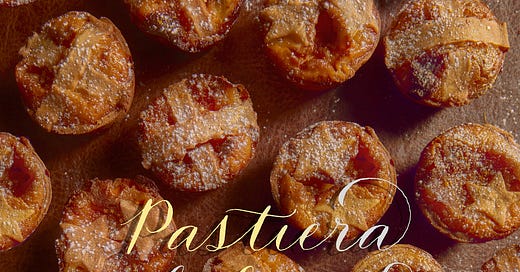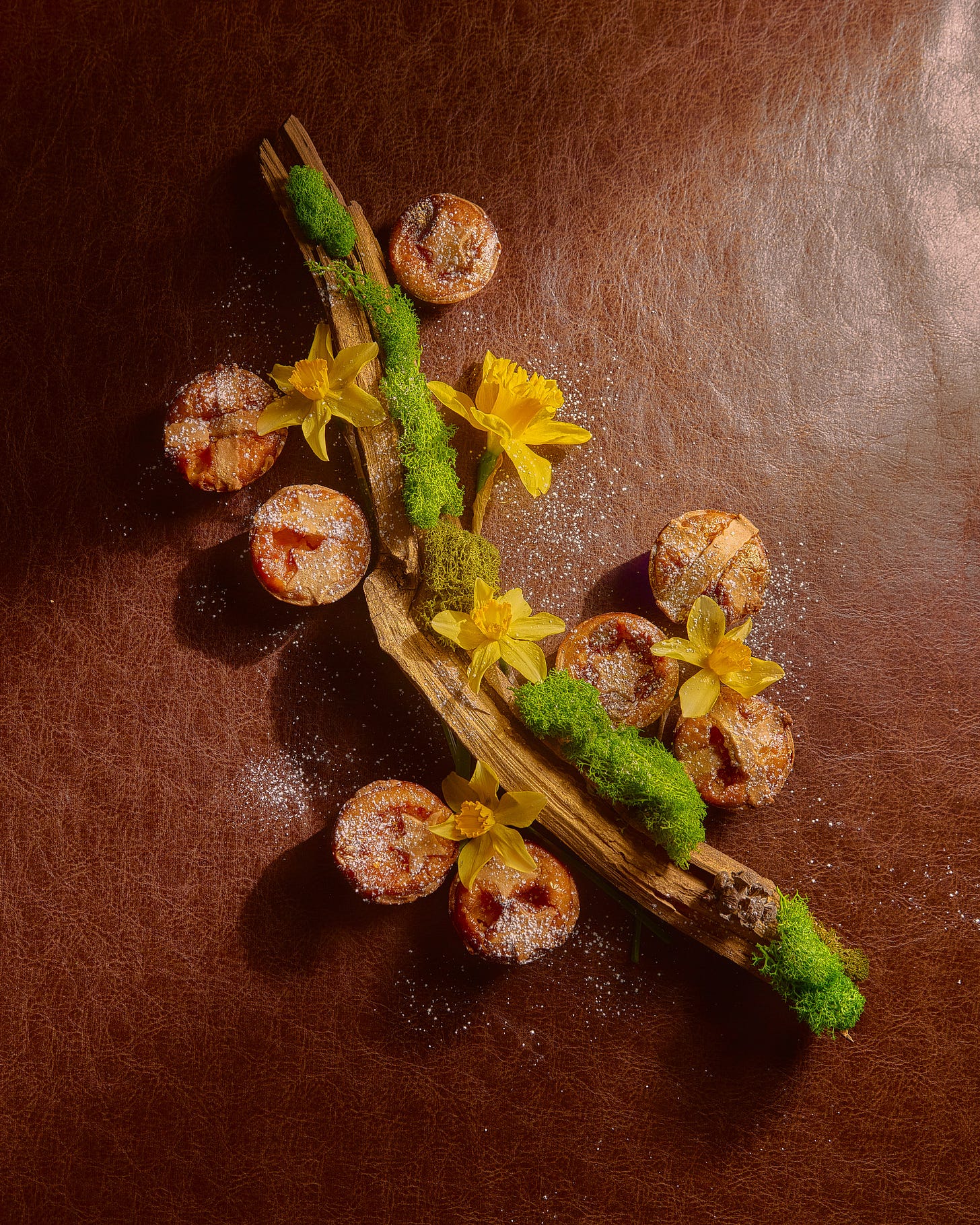Last year at this time, I embraced a previously detested traditional Easter dessert. You can read about that here. Pastiera is the type of dessert you make if you have a lot of time on your hands and I sure did, being out of work and also awaiting knee surgery.
It’s also the type of dessert that will take you days to accomplish, perhaps even a week, if done properly. It’s a pie traditionally made for the Easter holiday in the south of Italy, notably in the Campania region. I would argue it took Jesus less time to rise from the dead than it does to make this pie, if you will forgive the potentially sacrilegious comparison.
After a highly successful foray into pastiera making last year, I decided to change it up. Make it my own. Which, even more so than my biblical comparison, would be sacrilegious to many. Don’t mess with tradition. And for Italians, this means food.
However, I have to raise an eyebrow to that, because while Italians have about 2,395,729,587 different rules about food from how to prepare it, how to serve it and with what, to when to eat it, what to eat it with, and so on, everyone in Italy or of Italian descent seems to have a different opinion.
Why should I be any different? Why can’t I jump on that band wagon and say that my way is the right way? It seems that part of being Italian is claiming yourself as the ultimate authority on whatever it is you might be doing (just ask my dad), so I would argue that if I were to keep this recipe the very same, changing nothing while blindly following tradition, I would be decidedly UN-Italian.
And we can’t have that. Peccato!
Since that would be a shame, I have composed a successful sacrilegious and dare I say it, sacrilicious (thank you Homer Simpson) NEW recipe: Pastiera al Limone.
It combines the authenticity and delicate flavors of the original with added lemon flair in the form of lemon curd, and it’s at least three degrees more complicated than the previous version.
I’m going to tell you how to make this recipe (link to the previous version above), but I’m not going to recommend you make it.
What’s that?
That’s right. Don’t make this pie. This is no 3-ingredient, 30 minutes-or-less recipe for the fast-paced, chaotic, and mentally divergent lives we lead in the present. This is a recipe from the past. One that requires patience, time, some skill, and an attention span. It requires persistence over multiple days, specific steps, and at last count about 12 different ingredients. And it may require some long gone Italian grandma/kitchen witch whispering the exact instructions in your ear as you go.
That’s right, this dessert is a challenge, so instead of recommending you make it, I’m going to challenge you to make it.
You may ask, why should you do it my way?
I don’t know. Because while I guarantee it’s delicious, as is its predecessor, you should make your pastiera how you want. These days I’m less interested in tradition for tradition’s sake, and more interested in how people are adapting tradition to fit their lives. I believe this adaptability keeps tradition alive and fresh. Will I always put homemade lemon curd in my pastiera? Probably not. But the idea to do it this year, had me making the pie all over again, keeping the tradition alive for one more year, rather than forgetting about it.
I’ve already come up with next year’s variation. What’s yours?
In the meantime, here’s how I made my Pastiera al Limone:
Ingredients
Lemon Curd:
4 large egg yolks
2/3 cup granulated sugar
2 Tbsp lemon zest
1/3 cup fresh lemon juice (yes, I really did juice lemons from Italy that I received as a gift. Thank you, Mamma Agata)
1/8 tsp salt
6 Tbsp butter, cut into pieces and softened
Pasta Frolla
250 grams Type 00 Flour
1/2 tsp salt
100 g softened unsalted butter
80 g caster sugar
20 g honey
1 egg
40 g whole milk
1 tbsp each lemon and orange zest (I used a sumo orange)
Filling
200 g cooked wheat berries
1/2 tsp salt
100 g whole milk, divided
25 g unsalted butter
a strip each of lemon and orange peel
250 g sheep’s milk ricotta cheese
180 g caster sugar
50 grams citron
20 g honey
2 eggs and 1 egg yolk
1 Tbsp orange blossom water
1 Tbsp each lemon and orange zest
1/4 tsp freshly grated nutmeg
Process
To make the lemon curd:
Fill the bottom pot of a double boiler with 1–2 inches of water (or place a heat resistant glass bowl over a pot of water). Place on high heat. Once the water begins to boil, reduce to low heat to keep the water at a simmer.
Place egg yolks, granulated sugar, lemon zest, lemon juice, and salt into the top pot of the double boiler. Whisk until completely blended, then keep whisking as it cooks. Constant whisking prevents the egg yolks from curdling. The mixture will become thick, like a hollandaise sauce in about 10 minutes time. If you have a candy or instant-read thermometer, the temperature will rise to about 170°F (77°C). Be patient, it may take longer than 10 minutes.
Remove pan from heat. Whisk the sliced butter into the curd. The butter will melt from the heat of the curd as you whisk. Pour curd into a jar or bowl and place a piece of plastic wrap directly on top so it is touching the top of the curd. (This prevents a skin from forming on top.) The curd will continue to thicken as it cools.
Refrigerate the curd for up to about 10 days.
Make the Pasta Frolla:
Sift the flour and salt onto a work surface (I used a marble slab, but your kitchen countertop or table will do).
Create a well in the center like you are making fresh pasta. Essentially, push all the flour into a big “O” shape. Make sure to create enough empty space in the center, as you’ll be adding a lot of stuff and you need room to mix.
Place the butter and sugar in the center and mix those together with your hands. I like to use a bench knife so I can scrape any extra butter off my hands easily.
Add the honey to the butter and sugar and mix.
Add the egg, whole milk, and both citrus zests and mix.
Start to incorporate the flour into the wet ingredients, mixing with your hands and the bench knife.
Kneed together until a moist dough forms.
Cover with plastic wrap and store in the fridge. Can be made 2 days in advance.
Prepare the Wheat Berries:
Add the cooked wheat berries to a small sauce pan along with the salt, butter, 80 g whole milk and a strip each of lemon and orange peel.
Over low heat, bring the mixture to a simmer while stirring. Break up the wheat berries as your stir (a wooden spoon is handy here), as you don’t want any lumps. Do not allow the milk to boil and burn.
Once the mixture is simmering, remove from the heat.
Place the mixture in a tupperware container, cover and refrigerate for at least an hour. Can be made 1 day in advance.
Make the rest of the filling:
Combine the ricotta cheese with the sugar, and mix well with a spatula. Cover and refrigerate for at least 1 hour.
Place the citron and 1/2 the wheat berry mixture in a blender or food processor. Process just until the citron pieces are smaller and evenly distributed.
Add the blended wheat berries back to the other half and stir well.
After chilling, remove the cheese mixture from the fridge and add the honey and wheat berry mixture. Stir well.
In a small bowl, mix two eggs and one egg yolk with a fork. Add the orange blossom water, 20 g of whole milk, nutmeg, and the remaining lemon and orange zests to the eggs. Mix again!
Add the egg mixture to the cheese in two installments, mixing very well after each one.
Refrigerate this again for at least an hour or up to a day.
Assemble! Are you tired yet? Too bad!
Heat your oven to 350°F.
Remove the chilled pasta frolla from the fridge and cut off 1/3 of it with a bench knife.
Butter two muffin tins. I also cut thin strips of baking parchment and placed them along the bottom of each muffin well to aid me in lifting the pastry out of the tins once cooked.
Lightly flour a work surface and roll out the larger portion of dough into a circle, about 1/4” thick. Use a circular cookie cutter to cut rounds of dough that will fit into your muffin pan.
Place the dough circles into the muffin wells and poke holes into the bottoms with a fork.
Pour a tablespoon of the ricotta filling into each of the muffin wells and bang it once or twice on the table to even everything out.
Add a loaded teaspoon of the lemon curd on top of the ricotta filling, and then fill up the remaining real estate with the ricotta filling. Do this for each muffin well.
Roll out the remaining portion of pasta frolla to make strips for the lattice top. These will be pretty small because you are making muffins instead of an entire pie. I used two strips per muffin well and criss-crossed them. I also used star cookie cutters to mix it up a bit.
Place your pastiera in the oven and bake at 350°F for about 45-50 minutes. Check the muffins at 20 minutes and rotate them in your oven if necessary. The lemon curd caramelizes faster than the custard, so if necessary, tent any browning areas with foil.
You are looking for the top to be a beautiful orange caramel custard color. Do not remove it from the oven before it achieves that color.
Once it does, take it out and let it cool COMPLETELY in the pan. Seriously, don’t touch it. It will be a bit puffy when you take it out of the oven, but will fall slightly while it cools.
The next day, you can remove it from the pan, but you must let it rest for 24 hours before you eat it. If you don’t, the pastiera police will fine you. And anyway, you went through all this effort, shouldn’t you do the thing properly, including the eating?
Decorate with powdered sugar and edible gold glitter before serving.








I appreciate the invitation to slow down and steep in such a sweet culinary tradition. I need to take some baby steps to even begin to approach this, but I'm intrigued by the challenge to engage deeply in a process. Did you see the 2023 film "The Taste of Things" with Juliette Binoche? The director really lingered on the cooking processes in a way I found so satisfying - much like the enjoyment I get from reading all the steps of a recipe like this. I imagine a kitchen in a stone farmhouse with the windows flung open and the scent of herbs baking in the sun all around.
Elana---these look too delicious for words!! Your photos only enhance their appeal. Just wish I were trying them with you.